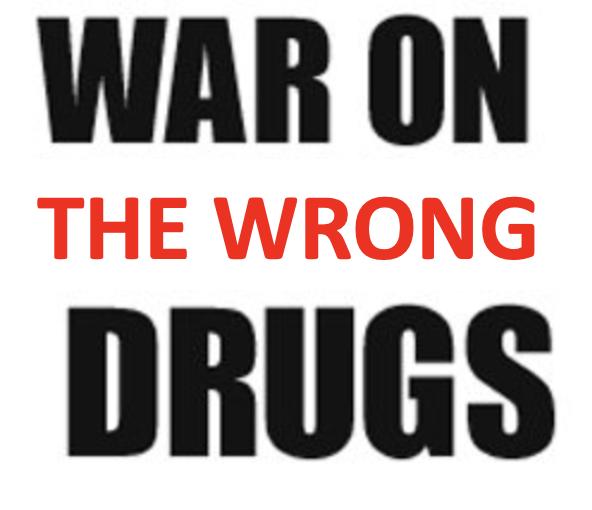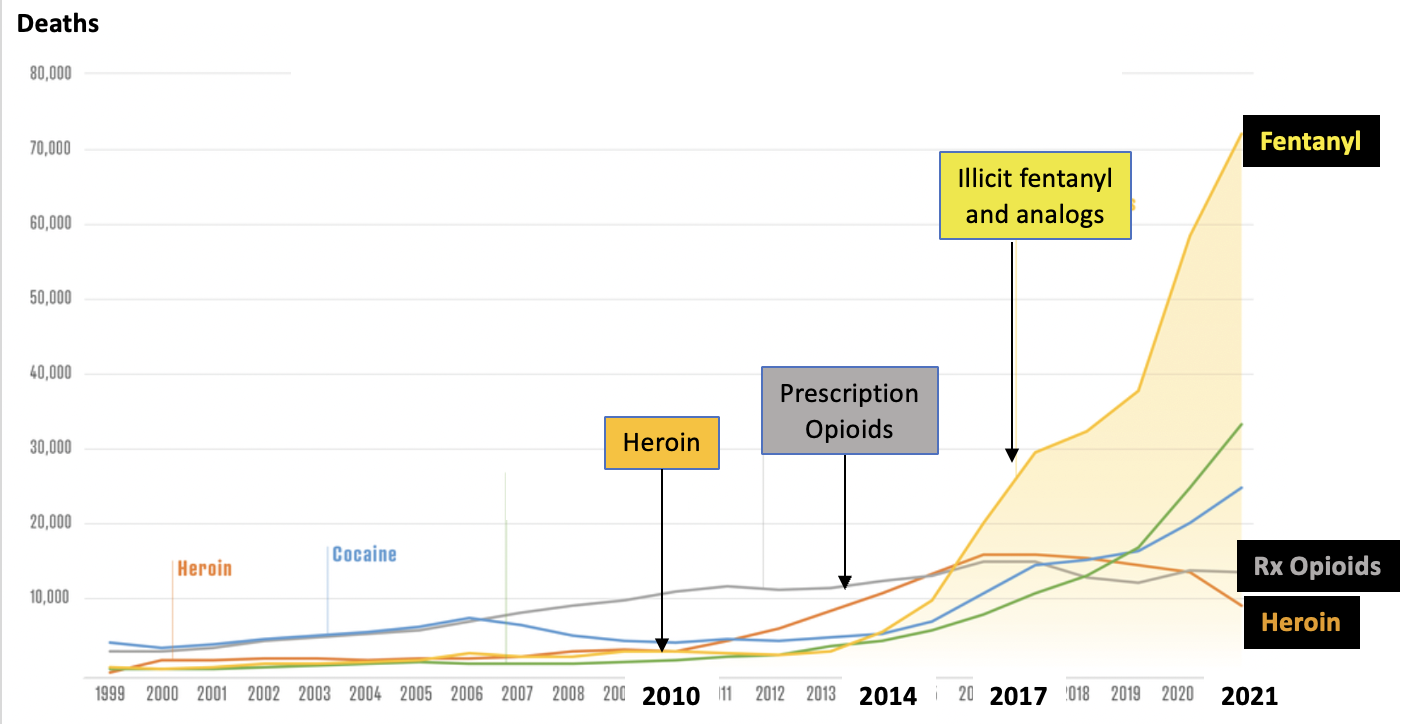
The recent investigative article in the Washington Post about the devastation that illegal fentanyl has brought to the US was clearly an enormously difficult job; about three dozen contributors were credited at the end of the piece, which is 5,909 words long. Unfortunately, it tells only part of the story, entirely leaving out the obvious connection between the demonization of opioid drugs, the plight of pain patients, and the subsequent proliferation of fentanyl overdoses and deaths. It isn’t until word # 1,393 that the Post even mentions what I and many others consider to be an element – perhaps the critical element – of the story: Opioid prohibition.
Although we need to give the Post journalists some credit for at least devoting 77 words that actually mention "opioid medications" and "fentanyl" in the same paragraph, it is disappointing that they did not further explore what millions of chronic patients and their physicians already know: That prescription opioid prohibition –something that is rarely mentioned in the press – is a cause, perhaps even the root cause of today's fentanyl problem.
When the U.S. government cracked down on the U.S. opioid industry starting in 2005, it choked off street supplies of prescription narcotics but left behind a ravenous market. Mexican cartels filled it, first with crude heroin, then fentanyl. The cartels imported drugs and chemicals from China, hired chemists and purchased pill presses. But at the moment when the federal agencies responsible for preventing the drug from gaining a foothold in America were needed most, they fell short. [My emphasis]
Federal agencies didn’t simply “fall short” in handling the oncoming plague. Not only did they completely botch the handling of the fentanyl crisis, but they were also partly (if not largely) responsible for creating it in the first place. Why? Bad policy, which my colleague Dr. Jeffrey Singer of the Cato Institute and an ACSH advisor has recently written about. "The “Iron Law of Prohibition” states that if a drug is banned or overly restricted, something more dangerous will take its place. This is precisely what happened. (Figure 1).

Figure 1. Overdose deaths from three drugs. Around 2010, heroin deaths (orange line), formerly rare, began to surge in response to the crackdown on prescription opioids that started around 2005. By 2014, deaths from illicit fentanyl (yellow line), previously very rare, began to track with those of heroin. By 2017, fentanyl had replaced heroin as the #1 killer, a trend that has skyrocketed ever since. Note that deaths from prescription opioids (gray line) have remained stable for a decade despite a 60% reduction since 2011 in prescriptions; these drugs now make up only a tiny fraction of all drug overdose deaths. The blue and green lines represent cocaine and meth, respectively. Just ignore them. Source: NIST
By “chok[ing] off both medical and street supplies of prescription narcotics,” these agencies, primarily the DEA, DOJ, and CDC, ignored the "Iron Law." Doing so predictably paved the way for a worse drug, heroin – and later fentanyl – to take over, doing far more harm than the pain pills, for example, Vicodin and OxyContin, ever did.
Anti-opioid zealots continue to refuse to concede the obvious: That today's fentanyl problem is a direct result of cracking down on prescription pain medications more than a decade ago. I cannot even conceive of a rational alternative explanation. Illicit fentanyl did not accidentally arrive in the US beginning around 2013; its appearance resulted from the same "ravenous" market forces that first caused the surge in heroin use. Fentanyl was nothing more than "improved heroin" to drug cartels.
Other comments and observations on the article
"Fentanyl is now the leading cause of death for Americans ages 18 to 49, according to a Post analysis"
Yet the anti-opioid crowd continues to call for even further cuts in producing and prescribing much safer prescription medications.
"DEA Administrator Anne Milgram acknowledged that the government remained too focused on heroin at the onset of the crisis, as Mexican traffickers ramped up production of synthetic opioids."
Yet, they're repeating the exact same mistake, worse really, wasting their time counting how many Percocet tablets a physician prescribes and persecuting doctors who the DEA deem are prescribing "too much," whatever that means. And this nonsense continues while illegal fentanyl continues to pour into the country via the Mexican border.
"Narcotics agents say street-level demand for fentanyl is rising fast because so many new users are getting hooked" [My emphasis]
Yet organizations such as Physicians for Responsible Opioid Prescribing (PROP) cling to the fallacy that legitimate prescription drugs are the root cause of today's addiction. The above statement proves that the PROP manifesto is dead wrong. The people who are now becoming addicted to (and falling prey to) street fentanyl are not doing so because they first got hooked on leftover Percocet from a medicine cabinet. Instead, they are buying something they think may be oxycodone on the street and getting fentanyl instead. Or perhaps simply buying fentanyl despite its know risks.
"The Centers for Disease Control and Prevention is unable to track overdose deaths in real-time. Its published data is one year behind, obscuring the picture of what is happening on the ground in 2022."
I would argue that the CDC is far more than one year behind. Between its pathetic handling of COVID and the coronaviruses that preceded it and its ill-advised and remarkably incompetent attempt to reduce drug addiction, I'd say two decades behind is more accurate. And maybe too generous.
"[In a sting designed to gather evidence against a man who was transporting what he thought was 4-ANPP] (1) One of the agents tossed a stun grenade at Daleo’s [the suspect] car. He crashed into a guardrail. The agents smashed Daleo’s driver’s side window, dragged him through it onto the ramp and carted him off in handcuffs."
Doesn't this sound a bit like DEA agents raiding legitimate doctor's offices?
[In 2017], the DEA published a 94-page resource document that devoted four pages to synthetic opioids. It made no mention that Mexican traffickers were producing fentanyl. Under “Drugs of Concern,” fentanyl was not listed.
This may be the single most astonishing part of the entire article. In 2016 I testified at an FDA hearing about minimizing opioid addiction and overdose deaths. None of the 15 other speakers even mentioned fentanyl, which, when it was my turn, I called "the devil in the room" and warned that it was already here and about to cause problems, unlike anything we've seen. (If the panel members even knew what fentanyl was, they hid it well.) Doesn't it seem odd that a single organic chemist from a tiny non-profit organization knew about a deadly drug that wasn't even on the DEA's radar one year later? This leaves me speechless. Go back up to Figure 1 and look at 2017. The death toll from fentanyl was roughly twice that of heroin, making it (by far) the most dangerous drug in the country. And the DEA either didn't know about it or chose not to mention this.
Did the Washington Post have an agenda?
Although this is speculation, I would argue yes. In an article that was nearly 6,000 words long and assembled by dozens of staff members, it only hints at – and barely – that there might be any connection between the crackdown on prescription painkillers and the proliferation of heroin and fentanyl.
Perhaps, the answer lies here.
In the new book, American Cartel, [Washinton Post reporters Scott] Higham and co-author Sari Horwitz make the case that the pharmaceutical industry operated like a drug cartel, with manufacturers at the top; wholesalers in the middle; and pharmacies at the level of "street dealers." What's more, Higham says, the companies collaborated with each other — and with lawyers and lobbyists — to create legislation that protected their industry, even as they competed for market share.
- NPR book review, American Cartel
Bias? I'll say. The Post (2) seems to be pushing the convenient and popular but wildly inaccurate narrative that blames the usual suspects, drug companies, and doctors for the fentanyl plague that grips this nation. But it's all wrong, something that the article itself disproves: "Narcotics agents say street-level demand for fentanyl is rising fast because so many new users are getting hooked."
No one ever lost points by attacking the pharmaceutical industry. But regardless of what companies did or did not do decades ago, it is patently ridiculous to blame the industry or doctors for what is happening today. But it is this politically correct but factually incorrect position that the Post has latched onto.
Is this why the paper couldn't spare a few of its 6,000 words to examine alternative (read: accurate) explanations for today's crisis? That's my bet. What's yours?
NOTE:
(1) 4-ANPP stands for 4-anilino-N-phenethyl-piperidine, the easiest precursor used to synthesize fentanyl, although I have written about how other chemicals can be used in their place.
(2) There are several similar reviews in the Post itself, but I haven't linked to them because all are behind paywalls.



